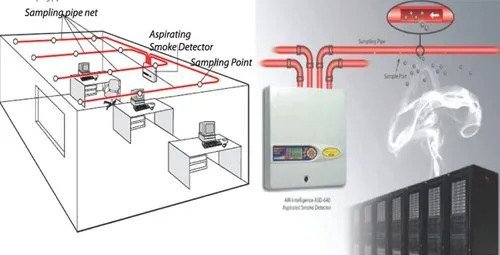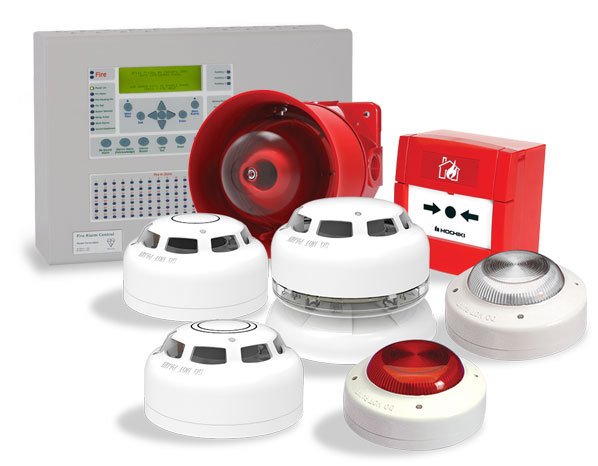When there is a fire, you need as much warning as possible to save lives and property. Fire detection is a crucial component in reducing the risk of disasters. It reduces the financial and material impacts of Dangers and prevents loss of life.
What Is an Early Warning Fire Detection System?
An Early Warning Fire Detection System is a specialized system made to detect the presence of a fire in its early stages before it spreads and causes significant damage. These systems are essential for saving lives, property, and the environment by allowing quick action to control and extinguish the fire. An Early Warning Fire Detection System is a fire detection system that offers the earliest possible warning of a potential fire.
Wermany is the leading supplier of Early Warning Fire Detection System in Dubai, Sharjah, Ajman, Abu Dhabi and all over UAE and Middle East. We are supplying and distributing all types of fire Detection and Fire Suppression Systems.

Main Components of an Early Warning Fire Detection System
- Sensors
- These kinds of systems typically use a variety of sensors to detect signs of flame or smoke. Some basic sensors include smoke detectors, heat detectors, and flame detectors. Each type of sensor is made to find specific fire-related situations.
- Control Panel
- The control panel is the main center of the fire detection system. It receives information from the sensors, processes the data, and triggers alarms when a flame or smoke is detected. It also provides information about the location of the detected event.
- Alarms
- Early Warning Fire Detection Systems can activate several alarms, including audible alarms such as sirens or bells and visual alarms (flashing lights). They can also send out remote notifications (such as notifications sent to smartphones or monitoring stations).
- Communication
- Many modern flame detection systems are connected to communication networks to alert building occupants, emergency services, or monitoring centers. This ensures that a quick response can be initiated when a fire is detected.
- Monitoring and Maintenance
- Regular monitoring and maintenance of the system is essential to ensure it remains in working order. This includes testing the sensors, checking the wiring, and replacing batteries or components as necessary.
Where are Fire Warning Systems being used?
Several industries, including oil and gas, power plants, and manufacturing, can benefit significantly from a flame detector. Fire detectors aid in preventing fires from starting in dangerous locations like scrapyards, shredder factories, and more.
Common Applications:
- Telecommunication centers
- Business Centers
- Data centers
- Clean rooms
- Server rooms
- Theaters
- Warehouses
- Indoor stadiums
- Convention Centers

Early Warning Fire Detection System ASD becomes the preferred option over spot-type smoke detectors in difficult environments where early and reliable detection of smoke is not possible with conventional point-type smoke detectors, such as in areas with extremely high or low temperature, high ambient airflow, large open spaces, dusty or corrosive areas.
Benefits of Early Warning Fire Detection System
An Early Flame Detection system plays a crucial role in protecting and preventing damage to the building and its contents by detecting a flame early and alerting the authorities so they can respond quickly. Fire detection is a crucial component in reducing the risk of disasters. It reduces the financial and material impacts of Dangers and prevents loss of life.
VESDA Aspirating Smoke Detection system
The VESDA name has become a symbol of high-performance very early warning smoke detection due to the hundreds of thousands of units installed worldwide. It is the product chosen when the best performance is required. VESDA is a very early warning aspirating smoke detection (ASD). VESDA ASD systems also can be fitted with components that detect hazardous/combustible gases to extend their ability above smoke detection to include gas detection and monitoring of the surroundings.
FAQ – Early Warning Fire Detection System
An Early Warning Fire Detection System is a specialized system designed to detect the presence of fires or fire-related hazards in their early stages, allowing for prompt response and mitigation.
These systems are crucial for early fire detection, which can save lives, protect property, and minimize environmental damage by enabling quick response and fire suppression.
Yes, many systems can be integrated with fire suppression systems, security systems, and building automation systems. This integration allows for a coordinated response to fire emergencies.
Regular testing and maintenance are essential to ensure system reliability. Testing should be conducted according to manufacturer recommendations and local regulations.
It’s essential to consult with a fire safety professional who can assess your specific needs and recommend an appropriate system based on factors like building size, occupancy, and local regulations. Feel free to contact us today on +971 50 965 7945
Early Warning Fire Detection System Installation Testing and Maintenance
Installation, testing, and maintenance are critical aspects of ensuring the effectiveness of an Early Warning Fire Detection System. Proper installation, routine testing, and regular maintenance help keep the system in optimal working condition to provide early warnings in the event of a fire. Here are the key considerations for each of these phases
Installation:
- Professional Installation: It’s essential to have the system installed by qualified professionals with experience in fire alarm systems. They should follow local building codes, regulations, and manufacturer guidelines.
- System Design: The design of the system should consider the layout of the building, the types of sensors needed, alarm zones, and the integration with other building systems, such as fire suppression and emergency lighting.
- Sensor Placement: Sensors should be strategically placed to provide comprehensive coverage while avoiding areas where false alarms may occur, such as near kitchens or bathrooms.
- Wiring and Power Supply: Ensure proper wiring and power supply for the system. Backup power sources, such as batteries or generators, should be in place to maintain system operation during power outages.
Testing:
- Initial Testing: After installation, conduct thorough initial testing to verify that all components are functioning correctly. This includes sensor activation, alarm signals, and communication with monitoring stations.
- Regular Testing: Regularly scheduled testing should be performed as per local regulations and manufacturer recommendations. Common tests include smoke sensitivity tests for smoke detectors, heat tests for heat detectors, and alarm audibility tests.
- False Alarm Testing: Test the system to ensure it does not produce false alarms due to factors like dust, insects, or electrical interference.
- Documentation: Maintain detailed records of all testing, including dates, results, and any necessary adjustments or repairs.
Maintenance:
- Scheduled Maintenance: Establish a routine maintenance schedule, which may include quarterly, semi-annual, or annual inspections, depending on local regulations and manufacturer guidelines.
- Sensor Cleaning: Regularly clean and inspect sensors to ensure they are free of dust, debris, or other obstructions that could affect their performance.
- Battery Replacement: Replace batteries as recommended by the manufacturer to ensure backup power is reliable.
- Record Keeping: Maintain comprehensive records of all maintenance activities, including any replacements or repairs made to the system.
- Monitoring Service: If the system is monitored by a central station or service provider, ensure that the monitoring service is functioning correctly and that emergency responders are alerted when necessary.
Early Warning Fire Detection System Supplier – Wermany
Wermany is the leading supplier of Fire Detection Systems in Dubai and all over Middle East. We are the UAE’s leading provider of fire detection and Early Warning systems, as well as fire alarm systems. We provide the best equipment and services to help detect fires and keep people safe.
What makes us special is that we never compromise on quality. Our team of experts carefully designs, installs, and maintains the fire detection systems to make sure they are the best they can be. We work with the best companies in the world to provide top-notch products and services. As the leading supplier in the region, we have established partnerships with the most reputable manufacturers and suppliers in the global fire detection industry. This enables us to offer an extensive range of state-of-the-art products and services, tailored to meet the unique needs of each customer.
Very Early Warning Fire Detection is a critical component of disaster risk reduction. We know that every second counts in an emergency, so our systems are designed to react quickly and accurately to keep people and property safe. For all types of fire detection system and fire protection Products feel free to Contact us Today
